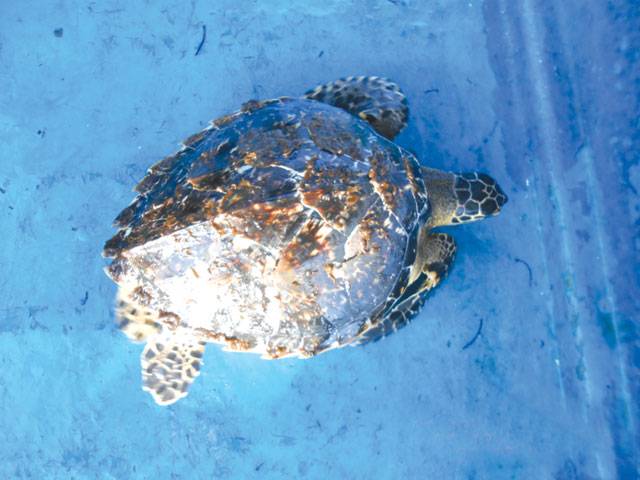KARACHI - A species of marine turtle which was not previously reported from Pakistan has been recorded for the first time by WWF-Pakistan from offshore waters of Pakistan with the help of local fishermen.
The Hawksbill sea turtle which is scientifically known as Eretmochelys imbricata was caught by a tuna gillnet from offshore waters near Ormara on Balochistan coast. Two species of marine turtles ie. Green and Olive Ridley turtles are reported from Pakistan; of which the Green turtle is the most common, nesting along the Sindh and Balochistan coast. Although no recent record of Olive Ridley turtle was reported from Pakistan but WWF-Pakistan has located large population of Olive Ridley in offshore waters of Pakistan during the last two years.
Last year another rare species i.e. Leatherback turtle was reported from Sur, Balochistan which was successfully released by the staff of WWF-Pakistan, other environmental organisations and local communities.
Rab Nawaz, Director, WWF-Pakistan informed that Hawksbill turtle is declared as a critically endangered sea turtle in 1996 under IUCN Red Data List because according to Marine Turtle Specialist Group of IUCN the worldwide hawksbill sea turtle population had declined by 80% and no significant population increase occurred since 1996.
Report of hawksbill turtle from Pakistan is a new addition to the diversified marine fauna of Pakistan. In the Indian Ocean, the Hawksbill turtle is widely distributed from African coast to the Persian Gulf, India and South and far-East Asian countries. He further pointed out previously only one dead shell of hawksbill was reported collected from Cape Monz, however, this cannot be authenticated independently.
The Hawksbill turtle has worldwide distribution in tropical and subtropical waters. Eretmochelys imbricata imbricata is found in Atlantic Ocean whereas Eretmochelys imbricata bissa is found in the Indo-Pacific region which is now reported from Pakistan as well.
Hawksbill turtles can easily be distinguished from other sea turtles by its sharp and curved beak and the saw-like appearance of its shell margins. Hawksbill turtle can grow up to 1m in length and weighing around 80 kg.
The Hawksbill turtle was caught on board tuna gillnet boat “Al Gul Muhammad” and Shah Zamin was its Nakhuda. The boat left for fishing on November, 22, 2013 and returned after a fishing trip 57 days returned on January 13, 2014. While fishing in the off Ormara, Hawksbill turtle having a carapace length of 47 cm. Muhammad Moazzam Khan, Technical Advisor (Marine Fisheries), WWF-Pakistan informed that all marine turtles including Hawksbill have been listed on Appendix I of the Convention on International Trade in Endangered Species (CITES), therefore, it is illegal to import or export turtle products, or to kill, capture, or harass hawksbill sea turtles. WWF-Pakistan has initiated training of fishermen to release turtles that are incidentally caught in the fishing gears. Vital data about the hawksbill turtle was recorded and fishermen have successfully released this hawksbill turtle which swam away.
Hawksbill turtles are omnivorous but sea sponges are the principal food (70–95%) in some areas. It also feed on algae, cnidarians, comb jellies and other jellyfish, and sea anemones. Normally hawksbill lays around 140 eggs which hatch after about 60 days. Turtle mature in about 20 years and lay eggs after every 2 or three years.
There is no authentic record of their breeding in Pakistani waters although coastal communities do report typical track of hawksbill in some isolated localities along Balochistan coast.
WWF-Pakistan since long has been involved in the conservation of marine and freshwater turtles and many projects have been implemented. Presently a turtle watch programme is implemented in Hawksbay area whereas monitoring of marine turtle population in offshore waters is being undertaken. The results have indicated a healthy population of Olive Ridley and green turtles in the offshore waters.
Friday, April 19, 2024
Hawkbill turtle spotted in Pakistan

Caption: Hawkbill turtle spotted in Pakistan
Faizabad commission report leaked, it should be made public now, suggests Abbasi
11:11 AM | April 19, 2024
MPCL makes new gas discovery in Sindh’s Marighazj formation
April 19, 2024
A Tense Neighbourhood
April 19, 2024
Dubai Underwater
April 19, 2024
X Debate Continues
April 19, 2024
Hepatitis Challenge
April 18, 2024
IMF Predictions
April 18, 2024
Kite tragedy
April 19, 2024
Discipline dilemma
April 19, 2024
Urgent plea
April 19, 2024
Justice denied
April 18, 2024
AI dilemmas unveiled
April 18, 2024
ePaper - Nawaiwaqt
Advertisement
Nawaiwaqt Group | Copyright © 2024





